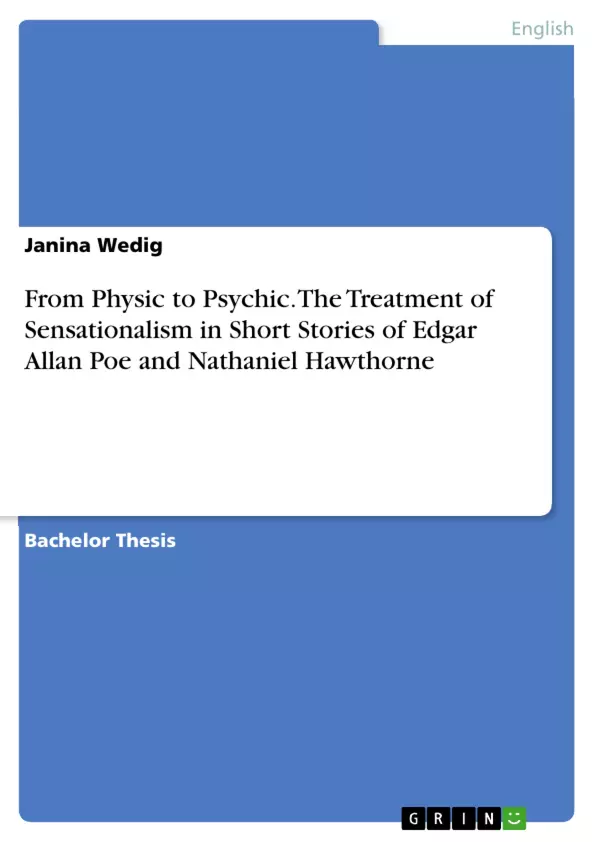For the longest time the genre of Sensationalism has been decried as cheap entertainment for the uneducated masses. Especially in the 19th century sensational writing has been frowned upon by the literary elite due to its commercialism and lowly or negative information value. Most authors of the time, who fancied they were serving the taste of an educated readership, distanced themselves from the sensational genre and denied its influence on their work. Therefore the actual impact of Sensationalism on 19th century literature has often been disregarded although in the case of some authors it is openly displayed. The aim of this paper is to demonstrate this impact by examining the reaction and response of the authors Edgar Allan Poe and Nathaniel Hawthorne towards literary and journalistic Sensationalism of their time and reveal how both authors exploited material and themes of the genre in different ways for their own purposes.
Inhaltsverzeichnis (Table of Contents)
- Introduction
- Sensationalism in Britain and Antebellum America
- A Brief History of Sensationalism
- Definition and Key Features
- Journalism
- Fiction
- Criticism and Defence
- Elitist Sensationalism a la Blackwood's
- Blackwood's Edinburgh Magazine
- The Blackwood's Sensation Tale
- Edgar Allan Poe's Sensationalism
- Poe and Parody
- Blackwood's Parodies in Psyche Zenobia's tales
- Exploitation of the Genre in “The Premature Burial”
- Hawthorne's Allegoric Sensationalism
- Hawthorne and Sensationalism
- Treatment and Transformation of Sensational Themes
- Psychological Sensationalism in \"Wakefield\"
- Sensational Material in \"Egotism; or, The Bosom Serpent\"
Zielsetzung und Themenschwerpunkte (Objectives and Key Themes)
This paper aims to demonstrate the impact of Sensationalism on 19th-century literature by examining how Edgar Allan Poe and Nathaniel Hawthorne reacted to and responded to contemporary journalistic and literary Sensationalism. The paper will explore how these authors utilized the genre's themes and materials for their own purposes.
- The historical development of Sensationalism in Britain and America
- The definition and key features of Sensationalist writing
- The influence of Blackwood's Edinburgh Magazine on the development of a specific form of Sensationalist fiction
- Poe's parody of Blackwood's sensational tales and his use of Sensationalist elements in his own stories
- Hawthorne's transformation of Sensationalist themes into allegorical and psychological narratives
Zusammenfassung der Kapitel (Chapter Summaries)
The first chapter provides a brief history of Sensationalism, tracing its origins back to the 16th century and examining its evolution in the 17th, 18th, and 19th centuries. It explores the changing nature of Sensationalist writing, highlighting its transition from religious moralizing to an emphasis on individual psychology and the exploration of crime and its motives. The chapter also examines the growing popularity of Sensationalism in the 19th century, with the rise of mass media and the proliferation of newspapers.
The second chapter delves into the specific characteristics of Blackwood's Edinburgh Magazine, a prominent Scottish periodical of the 19th century. It discusses the magazine's role in promoting a particular type of Sensationalist fiction, characterized by its elitist nature and focus on psychological horror. The chapter explores the magazine's influential writers and their contributions to the development of a distinct Blackwood's style.
Chapter four focuses on Poe's relationship with Blackwood's Magazine and his attempts to parody the magazine's brand of Sensationalism. It examines Poe's short stories, "How to Write a Blackwood Article" and "A Predicament," which are considered satires of Blackwood's sensationalist fiction. The chapter also explores how Poe exploited sensationalist elements in his own stories, notably in "The Premature Burial," by exaggerating and ridiculing the extreme physical experiences often depicted in Blackwood's tales.
Chapter five shifts its attention to Hawthorne and his engagement with Sensationalism. The chapter examines Hawthorne's stories "Wakefield" and "Egotism; or, The Bosom Serpent," showcasing how he employed sensational material while transforming those themes into more allegorical and psychological narratives. It argues that Hawthorne's brand of Sensationalism, unlike Poe's, focuses less on physical violence and more on the exploration of internal psychological states and moral complexities.
Schlüsselwörter (Keywords)
This paper focuses on the themes of Sensationalism, 19th-century literature, Gothic fiction, Blackwood's Edinburgh Magazine, Edgar Allan Poe, Nathaniel Hawthorne, parody, psychological horror, and the relationship between journalism and fiction.
- Quote paper
- Janina Wedig (Author), 2013, From Physic to Psychic. The Treatment of Sensationalism in Short Stories of Edgar Allan Poe and Nathaniel Hawthorne, Munich, GRIN Verlag, https://www.grin.com/document/266364



